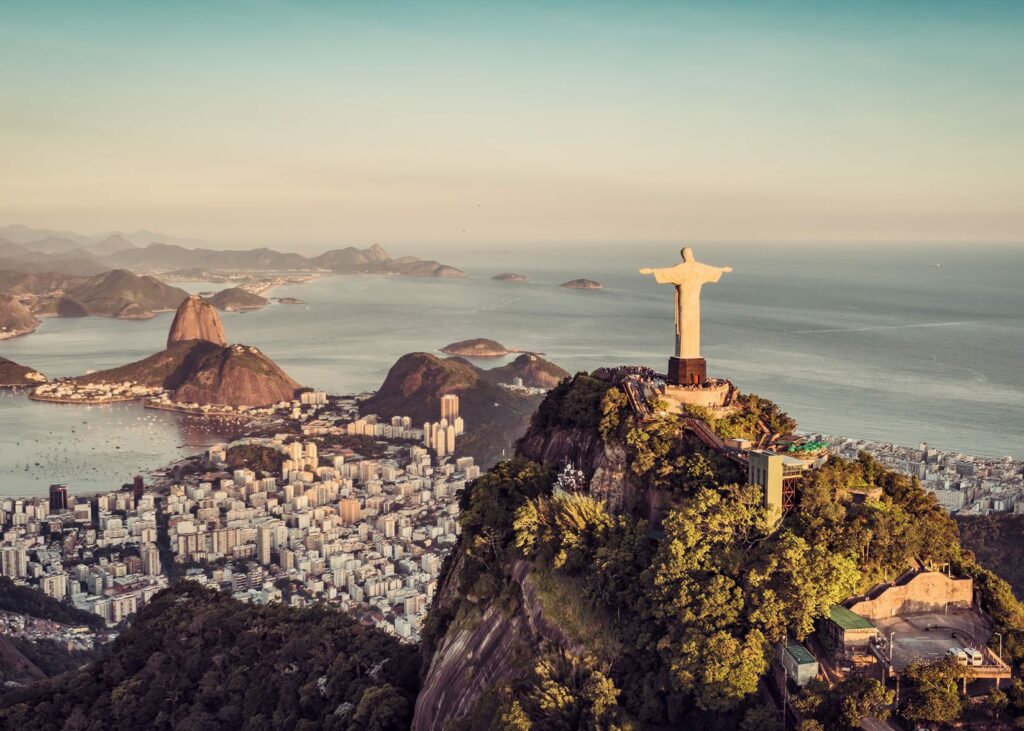With over 450 years of history, it is the combination of geographical features – the sea, the mountains, the forests – along with human presence that bestows upon Rio de Janeiro its unique status. Several parts of the city are enveloped in extraordinary landscapes. It was the first city in the world to receive the UNESCO title of World Heritage in the Cultural Landscape category.
There’s nothing more traditional to experience the energy of the Brazilian people than enjoying Rio’s Carnival. There are various options to savor one of the world’s most famous festivals, such as watching the samba school parades or joining in the street carnival, where each neighborhood in the city has its favorite block party.

Rio de Janeiro’s main tourist attractions are true gems of the city. The Sugarloaf Mountain, situated 396 meters above sea level, is connected to the Urca Hill by a historic cable car, being the pioneer in Brazil and the third in the world. In contrast, the Christ the Redeemer, with its outstretched arms over Guanabara Bay, is a monumental Art Deco sculpture atop Corcovado Mountain, famous worldwide.
Additionally, the Tijuca National Park offers a natural refuge in the heart of the city, with its imposing mountains, caves, waterfalls, and trails that provide breathtaking views. Adventurers have the opportunity to practice rock climbing, hang gliding, and other thrilling activities here.
The city of Rio de Janeiro is not limited to these iconic destinations. It also offers a variety of cultural and historical experiences, such as tours of the Botanical Garden, Lage Park, and the charming Santa Teresa tram. Visiting the Metropolitan Cathedral and the Museum of Modern Art and the Museum of Tomorrow are other fascinating options. The Municipal Theatre, inaugurated in 1909, is an important performing arts center in Brazil and Latin America.
Those seeking nightlife and entertainment will find a vibrant bohemian scene in the Lapa neighborhood, filled with bars and lively options. Furthermore, Rio offers the Rio Star, the largest Ferris wheel in Latin America, and AquaRio, the largest aquarium in South America, with an impressive collection of around three thousand animals.
The city is also perfect for exploring on foot, with walks beyond the famous boardwalks of Copacabana, Ipanema, and Leblon. Rodrigo de Freitas Lagoon is a popular destination for leisure, with kiosks, recreational areas, skate parks, restaurants, and charming landscapes of forests and mountains.
Sports are an integral part of Carioca culture, and the city offers a wide range of activities. From hang gliding from the Pedra Bonita ramp to challenging climbs on hills like Pedra da Gávea and Bico do Papagaio, there are options for adventurers of all levels. On the beaches, beach volleyball, soccer, and footvolley matches are common, reflecting the Cariocas’ love for sports. In summary, Rio de Janeiro is a destination that caters to all tastes and interests.







Plane | Airport
+55 (21) 3004-6050
Tom Jobim International Airport receives flights from many cities within Brazil and from around the world. If you are already in Brazil, you can choose to arrive at Santos Dumont Airport.
Bus
+55 (21) 3213-1800
If you are coming from another city in Brazil, you can take a bus to Novo Rio Bus Terminal, which is close to the city center and the South Zone. There are daily arrivals from major Brazilian bus companies.
Watercraft
+55 (21) 2233-2762
Several cruises also make stops at the Port of Rio de Janeiro. The itinerary varies depending on the company and the packages booked.
Bus
Rio de Janeiro is well-covered by a variety of bus lines. Here are the lines that pass by the city’s main tourist attractions.
Walking
Strolling through the streets of Rio de Janeiro is delightful, especially along the boardwalks of Copacabana, Leblon, and Ipanema beaches.
Subway/Train
Rio de Janeiro’s subway system is safe, efficient, and easy to use. Tickets are sold at counters and self-service machines. The Metrô Rio operates from Monday to Saturday from 5 am to midnight and on Sundays and holidays from 7 am to 11 pm. Check the station map.
Light Rail (VLT)
The VLT is a modern, safe, accessible, and sustainable mode of transportation that connects neighborhoods in the Port Region to the city center. It is the main connection for those traveling through the central area of Rio de Janeiro.
Taxi and Ride-Sharing
Apps Taking a taxi or using ride-sharing apps is one of the more convenient options for getting around the city.
Riotur - Tourist Information:
+55 (21) 3460-1746
Tourist Police Station:
+55 (21) 2332-2924
Military Police: 190
Paramedics: 192
Fire Department: 193
110V
Rio de Janeiro generally has a warmer climate. The best time to visit the city is from June to September. To explore Rio, opt for light and comfortable clothing.

